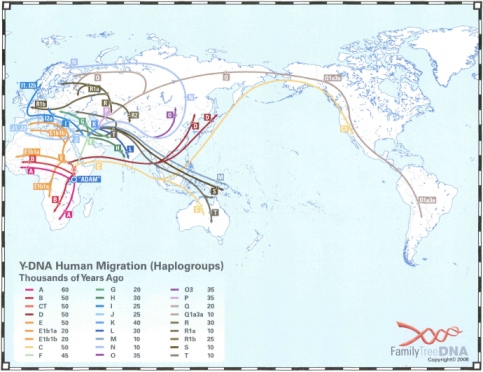Haplogroups Explained
Haplogroups can be used to trace the path of man's migration around the world since his origination in Africa. As man migrated, he adapted to his surroundings. These adaptations can be seen in the lightened skin color due to the lack of sun away from the equator, stockier build as observed in peoples in the Arctic regions to maintain body-heat, and better oxygen absorption capability as seen in inhabitants of mountainous, oxygen-poor regions.
Another common term used in genetics is haplotype. If you can imagine a haplogroup as the branch of a tree, a haplotype is an individual leaf on that branch. Because some haplotypes are found to be more common within particular haplogroups, it is very often possible to make a prediction of what your haplogroup is from your haplotype.
Haplogroups allow genealogists to gain some insight into their very 'deep' ancestry – i.e. information about their direct paternal or maternal ancestors who lived thousands of years ago.
Y-DNA Haplogroup Geographic Locations
- Haplogroup A is found mainly in Southern Africa and represents the oldest Y-chromosome haplogroup. It is believed to be the haplogroup of Y-chromosomal Adam.
- Haplogroup E1b1a is predominantly found among sub-Sahara African populations.
- Haplogroup E1b1b is predominantly found around the coast of the Mediterranean.
- Haplogroup G has an overall low frequency in most populations and is found widely distributed in Europe, northern and western Asia, northern Africa, the Middle East and India.
- Haplogroup J and its subgroups are predominantly found around the coast of the Mediterranean and the Middle East. Subgroups are frequently associated with Jewish populations.
- Haplogroup I and its subgroups are predominantly found in northwestern Europe (Scandinavia) and central Europe. One subgroup is considered to be Viking.
- Haplogroup N is predominantly found in northeastern Europe and especially in Finland.
- Haplogroup Q is primarily associated with Native American populations.
- Haplogroup R1a and its subgroups are predominantly found in eastern Europe and in western and central India and Asia. In eastern Europe, it is frequently associated with Slavic populations.
- Haplogroup R1b and its subgroups are predominantly found in western Europe and the British Isles. It is the most common haplogroup in Europe and a subgroup of R1b is believed by some researchers to be Celtic.



